The OCZ Vector 180 (240GB, 480GB & 960GB) SSD Review
by Kristian Vättö on March 24, 2015 2:00 PM EST- Posted in
- Storage
- SSDs
- OCZ
- Barefoot 3
- Vector 180
Sequential Read Performance
Our sequential tests are conducted in the same manner as our random IO tests. Each queue depth is tested for three minutes without any idle time in between the tests and the IOs are 4K aligned similar to what you would experience in a typical desktop OS.
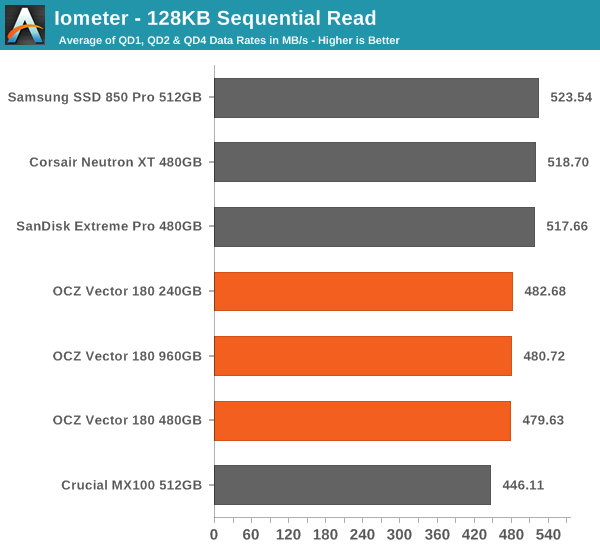
Sequential read performance is decent, but it leaves a bit to be desired to match the other high-end SSDs.
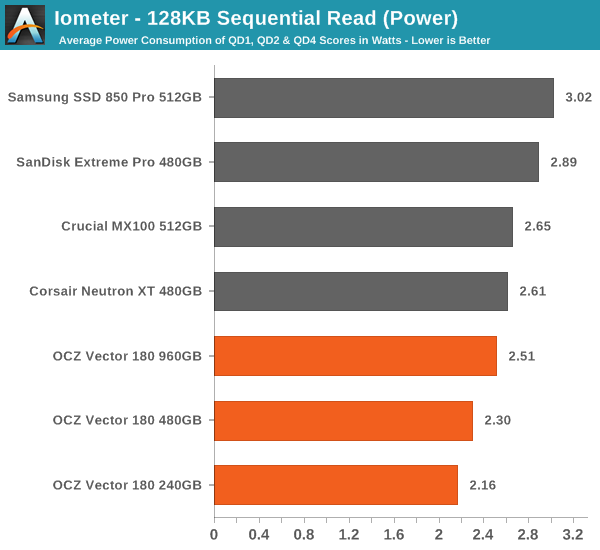
Fortunately the power characteristics are still very good despite the slight lack of performance.
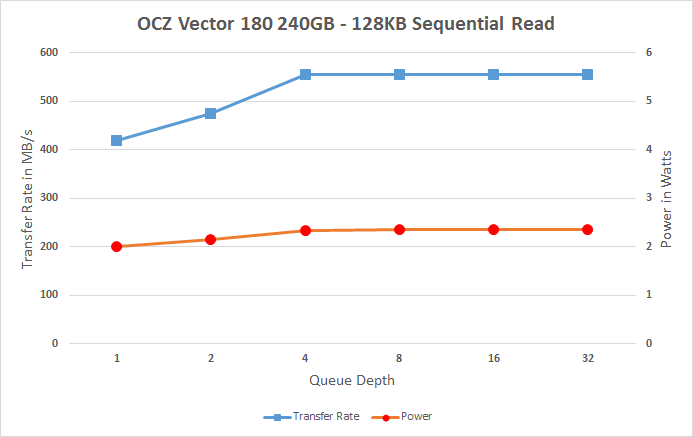 |
|||||||||
The performance at queue depths of 1 and 2 (i.e. the most common ones) leaves room for improvement, but practically every drive is maxing out SATA 6Gbps at QD4 and higher.
Sequential Write Performance
Sequential write testing differs from random testing in the sense that the LBA span is not limited. That's because sequential IOs don't fragment the drive, so the performance will be at its peak regardless.
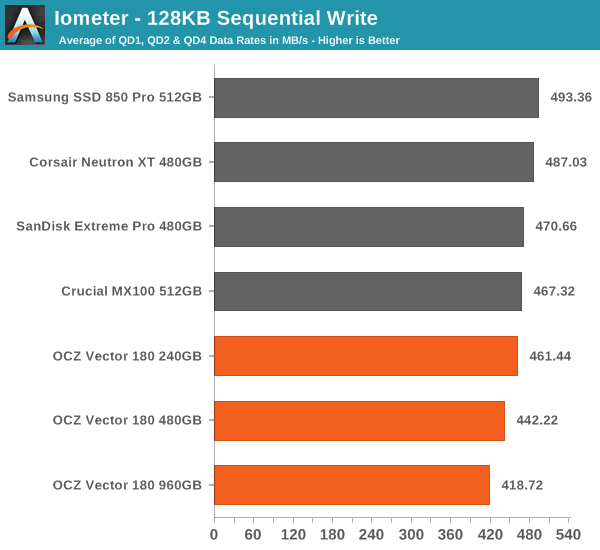
The Vector 180 doesn't do any better in sequential writes and especially the 960GB model is surprisingly slow. It's quite evident that the Barefoot 3 was never designed with such a large capacity in mind as there is clearly some performance loss due to additional LBA tracking from extra NAND.
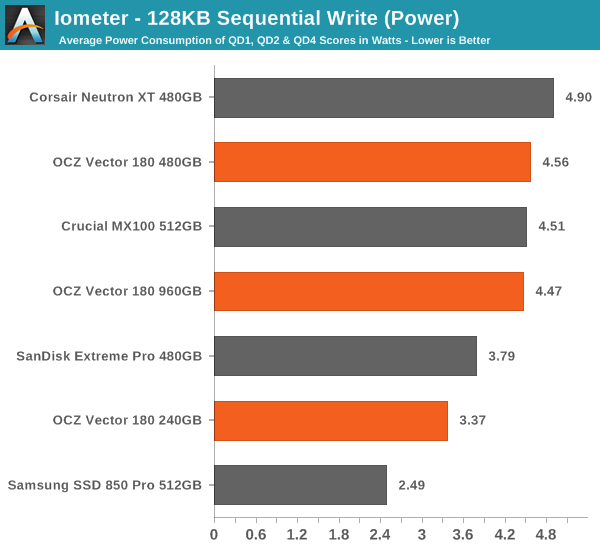
This time the power consumption isn't too good either.
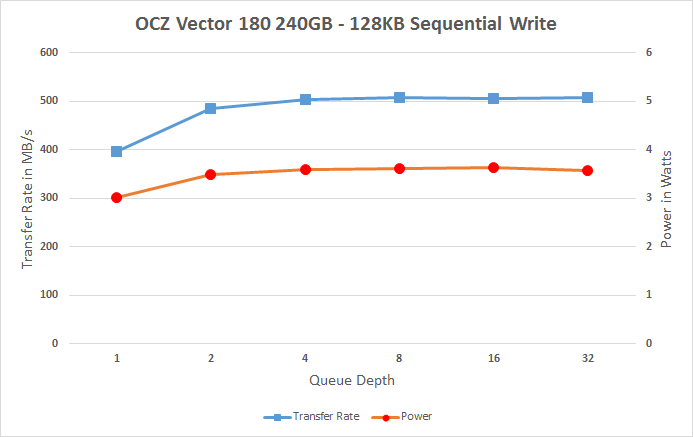 |
|||||||||
While the performance scales pretty nicely, the Vector 180 seems to hit a wall at 500MB/s (450MB/s for the 960GB model). That's pretty far from the 530MB/s that OCZ rates the sequential write at.










89 Comments
View All Comments
nathanddrews - Tuesday, March 24, 2015 - link
This exactly. LOLSamus - Wednesday, March 25, 2015 - link
Isn't it a crime to put Samsung and support in the same sentence? That companies Achilles heal is complete lack of support. Look at all the people with GalaxyS3's and smart tv's that were left out to dry the moment next gen models came out. And on a polarizingly opposite end of the spectrum is Apple who still supports the nearly 4 year old iPhone 4S. I'm no Apple fan but that is commendable and something all companies should pay attention too. Customer support pays off.Oxford Guy - Wednesday, March 25, 2015 - link
Apple did a shit job with the white Core Duo iMacs which all develop bad pixel lines. We had fourteen in a lab and all of them developed the problem. Apple also dropped the ball on people with the 8600 GT and similar Nvidia GPUs in their Macbook Pros by refusing to replace the defective GPUs with anything other than new defective GPUs. Both, as far as I know, caused class-action lawsuits.Oxford Guy - Wednesday, March 25, 2015 - link
I forgot to mention that not only did Apple not actually fix the problem with those bad GPUs, customers would have to jump through a bunch of hoops like bringing their machines to an Apple Store so someone there could decide if they qualify or not for a replacement defective GPU.matt.vanmater - Tuesday, March 24, 2015 - link
I am curious, does the drive return a write IO as complete as soon as it is stored in the DRAM?If so, this drive could be fantastic to use as a ZFS ZIL.
Think of it this way: you partition it so the size does not exceed the DRAM size (e.g. 512MB), and use that partition as ZIL. The small partition size guarantees that any writes to the drive fit in DRAM, and the PFM guarantees there is no loss. This is similar in concept to short-stroking hard drives with a spinning platter.
For those of you that don't know, ZFS performance is significantly enhanced by the existence of a ZIL device with very low latency (and DRAM on board this drive should fit that bill). A fast ZIL is particularly important for people who use NFS as a datastore for VMWare. This is because VMWare forces NFS to Sync write IOs, even if your ZFS config is to not require sync. This device may or may not perform as well as a DDRDRIVE (ddrdrive.com) but it comes in at about 1/20th the price so it is a very promising idea!
ocztosh -- has your team considered the use of this device as a ZFS array ZIL device like i describe above?
Kristian Vättö - Tuesday, March 24, 2015 - link
PFM+ is limited to protecting the NAND mapping table, so any user data will still be lost in case of a sudden power loss. Hence the Vector 180 isn't really suitable for the scenario you described.matt.vanmater - Wednesday, March 25, 2015 - link
OK good to know. To be honest though, what matters more in this scenario (for me) is if the device returns a write io as successful immediately when it is stored in DRAM, or if it waits until it is stored in flash.As nils_ mentions below, a UPS is another way of partially mitigating a power failure. In my case, the battery backup is a nice to have rather than a must have.
matt.vanmater - Tuesday, March 24, 2015 - link
One minor addition... OCZ was clearly thinking about ZFS ZIL devices when they announced prototype devices called "Aeon" about 2 years ago. They even blogged about this use case:http://eblog.ocz.com/ssd-powered-clouds-times-chan...
Unfortunately OCZ never brought these drives to market (I wish they did!) so we're stuck waiting for a consumer DRAM device that isn't 10+ year old technology or $2k+ in price tag.
nils_ - Wednesday, March 25, 2015 - link
Something like the PMC Flashtec devices? Those are boards with 4-16GiB of DRAM backed by the same size of flash chips and capacitors with a NVMe interface. If the system loses power the DRAM is flushed to flash and restored when the power is back on. This is great for things like ZIL, Journals, doublewrite buffer (like in MySQL/MariaDB), ceph journals etc..And before it comes up, a UPS can fail too (I've seen it happen more often than I'd like to count).
matt.vanmater - Wednesday, March 25, 2015 - link
I saw those PMC Flashtec devices as well and they look promising, but I don't see any for sale yet. Hopefully they don't become vaporware like OCZ Aeon drives.Also, in my opinion I prefer a SATAIII or SAS interface over PCI-e, because (in theory) a SATA/SAS device will work in almost any motherboard on any Operating System without special drivers, whereas PCI-e devices will need special device drivers for each OS. Obviously, waiting for drivers to be created limits which systems a device can be used in.
True PCI-e will definitely have greater throughput than SATA/SAS, but the ZFS ZIL use case needs very low latency and NOT necessarily high throughput. I haven't seen any data indicating that PCI-e is any better/worse on IO latency than SATA/SAS.